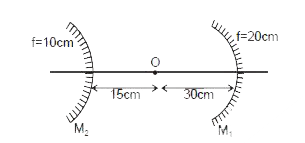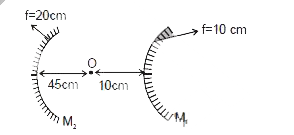The field of view is maximum when image is formed by reflection at
plane mirror
convex mirror
concave
cylindrical mirror
The correct Answer is:B
To solve the question "The field of view is maximum when the image is formed by reflection at," we need to analyze the different types of mirrors and their effects on the field of view.
1. Understanding the Types of Mirrors:
- Plane Mirror: Reflects light to produce an image that is the same size as the object, maintaining the same height.
- Convex Mirror: Curves outward and diverges light rays, producing a virtual image that is smaller than the object but allows a wider field of view.
- Concave Mirror: Curves inward and converges light rays, producing a real image that can be larger or smaller depending on the object's distance from the mirror.
- Cylindrical Mirror: Has a cylindrical shape and is used for specific applications but does not significantly affect the field of view.
2. Analyzing the Field of View:
- The field of view refers to the extent of the observable world that can be seen at any given moment.
- A mirror that allows for a wider field of view will enable us to see more of the surroundings.
3. Comparing the Mirrors:
- Plane Mirror: Provides a limited field of view since it only reflects what is directly in front of it.
- Convex Mirror: Expands the field of view significantly because it diverges light rays and allows us to see a larger area behind and to the sides of the mirror.
- Concave Mirror: Generally reduces the field of view as it focuses light and can create a smaller image.
- Cylindrical Mirror: Not commonly used for maximizing field of view.
4. Conclusion:
- Among the options, the convex mirror provides the maximum field of view because it allows more light to enter and reflects a wider angle of view.
Final Answer:
The field of view is maximum when the image is formed by reflection at a convex mirror.
---
- Plane Mirror: Reflects light to produce an image that is the same size as the object, maintaining the same height.
- Convex Mirror: Curves outward and diverges light rays, producing a virtual image that is smaller than the object but allows a wider field of view.
- Concave Mirror: Curves inward and converges light rays, producing a real image that can be larger or smaller depending on the object's distance from the mirror.
- Cylindrical Mirror: Has a cylindrical shape and is used for specific applications but does not significantly affect the field of view.
- The field of view refers to the extent of the observable world that can be seen at any given moment.
- A mirror that allows for a wider field of view will enable us to see more of the surroundings.
- Plane Mirror: Provides a limited field of view since it only reflects what is directly in front of it.
- Convex Mirror: Expands the field of view significantly because it diverges light rays and allows us to see a larger area behind and to the sides of the mirror.
- Concave Mirror: Generally reduces the field of view as it focuses light and can create a smaller image.
- Cylindrical Mirror: Not commonly used for maximizing field of view.
- Among the options, the convex mirror provides the maximum field of view because it allows more light to enter and reflects a wider angle of view.
The field of view is maximum when the image is formed by reflection at a convex mirror.
Similar Questions
Knowledge Check
- Question 1 - Select One
The field of view is maximum when image is formed by reflectiori at
Aplane mirrorBconvex mirrorCconcaveDcylindrical mirror - Question 2 - Select One
The firld of view is maximum for
Aplane mirrorBconcave mirrorCconvex mirrorDcylindrical mirror - Question 3 - Select One
The magnifiying power of simple microscope is maximum when image is formed at _____
AinfinityBfocusCtwice the focusDD.D.V.
Use Of Image Or Reflection
View SolutionA converging mirror M1 a point source S and a diverging mirror M2 are arranged as shown in figure. The source is placed at a distance of 30 cm from M1. The focal length of each of the mirrors is 20 cm. Consider only the images formed by a maximum of two reflections. It is found that one image is formed on the source itself. (a) Find the distance between the two mirrors. (b) Find the location of the image formed by the single reflection from M_2
 View Solution
View SolutionA real image is formed when two or more
View SolutionWhen an object is kept within the focus of a concave mirror, an enlarged image is formed behind the mirror. The nature of the image is
View SolutionWhen an object is kept within the focus of a concave mirror, an enlarged image is formed behind the mirror. This image is :
View Solution



